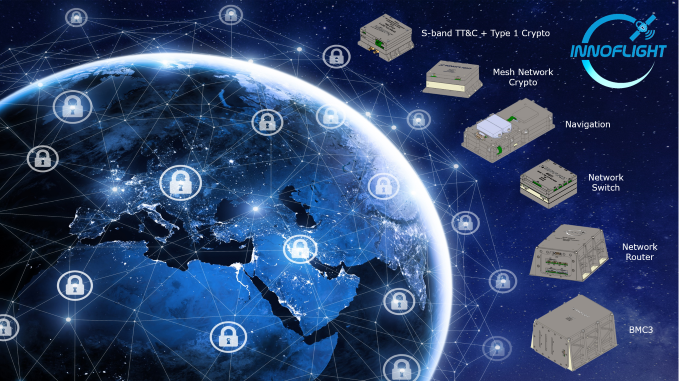
Northrop Grumman chose Innoflight as a strategic avionics supplier for the Space Development Agency (SDA) Tranche 1 Transport Layer (T1TL) program. (Photo: Innoflight)
San Diego-based Innoflight CEO Jeff Janicik said a contract with Northrop Grumman to provide avionics equipment for U.S. Space Development Agency (SDA) low earth orbit (LEO) space vehicles, announced this month, is the start “a lot more work in the future” on space-based communications for the aerospace technology firm.
“This is a very meaningful contract for Innoflight,” Janicik told Avionics International in an interview. “It’s validation of an original mission and vision of the company [founded in 2005], which [foresaw] the emergence of a smaller, more agile approach to space–the proliferated constellation, the resilient architectures. These are the things that coincide with the way we saw space solutions coming to prominence.”
Describing Innoflight’s capabilities, Janicik said: “We build space computers, we build advanced processors, we build storage and network processing, basically anything under the umbrella of space processors and computers.”
Northrop Grumman Strategic Space Systems was awarded a potentially $700 million prototype contract from SDA in February 2022 to research and develop 42 Tranche 1 Transport Layer (T1TL) satellite space vehicles to be ready for launch in 2024. Lockheed Martin and York Space Systems were also awarded T1TL space vehicle contracts by SDA.
SDA has said T1TL will be a “mesh network” of 126 LEO space vehicle satellites enabling “a resilient, low-latency, high-volume data transport communication system … [allowing for] global communications access and … persistent regional encrypted connectivity.”
Innoflight will deliver to Northrop S-band software-defined radios for Telemetry, Tracking and Control (TT&C) data links, Type-1 “bulk” and “mesh network” End Cryptographic Units (ECUs), network Internet Protocol (IP) routers with Multi-Protocol Label Switching (MPLS), network Ethernet switches, flight processors with on-orbit data storage and precision navigation timing.
Deliveries of some equipment will start as early as this spring, Janicik said.
Janicik noted the LEO communications network being planned by SDA is “very similar to the way terrestrial networks work, especially when you start looking at wireless aspects,” he explained. “There are some more advanced networking protocols used in space. The challenge is you’ve got greater distances, either in space or [from space] to the ground.”
Janicik said security will be a key function of the equipment Innoflight is providing to Northrop. “You have to secure these connections,” he noted. “You have to authenticate the different nodes and that is done through the electronics. The challenge is interoperability, the same as it was when terrestrial wireless networks started becoming more common when WiFi was established.”
Janicik said supply chain bottlenecks are a barrier to be overcome by Innoflight and other avionics suppliers. “Organizations like the Space Development Agency recognize that,” he explained. “But when you get to large quantities [of parts], it’s a large risk for our company. We’re still a small-size company, but it’s a risk for even the big suppliers in space technology. And in some cases, we’re going up against the automotive industry and computer industry [for parts], depending on what kind of class of parts you’re talking about. So, everyone’s vying for those parts.”
Because of supply chain delays, the Innoflight CEO said it is critical for space avionics suppliers to know “what’s coming down the pipeline” as far in advance as possible. “That’s the tough part—knowing exactly what’s coming down the pipe and what needs to be built,” Janicik said. “You don’t really know that until the requirements are set. It’s a little bit of a challenge.”
The value of the Northrop-Innoflight contract was not disclosed.